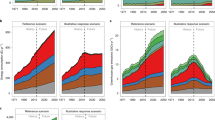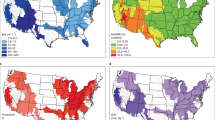Abstract
In this paper we develop a novel, comprehensive method for estimating the global human carrying capacity in reference to food production factors and levels of food consumption. Other important interrelated dimensions of carrying capacity such as energy, non-renewable resources, and ecology are not considered here and offer opportunities for future work. Use of grain production (rain-fed/irrigated), animal product production (grazing/factory farm), diet pattern (grain/animal products), and a novel water accounting method (demand/supply) based on actual water consumption and not on withdrawal, help resolve uncertainties to find better estimates. Current Western European food consumption is used as a goal for the entire world. Then the carrying capacity lies in the range of 4.5–4.7 billion but requiring agricultural water use increase by 450–530% to 4725–5480 km3, the range based on different estimates of available water. The cost of trapping and conveying such water, will run 4.5–13.5 trillion over 50 years requiring an annual spending increase of 150–400%, straining the developing world where most of the population increase is expected. We reconfirm estimates in the literature using a dynamic model. ‘Corner scenarios’ with extreme optimistic assumptions were analyzed using the reasoning support software system GLOBESIGHT. With a hypothetical scenario with a mainly vegetarian diet (grazing only with 5% animal product), the carrying capacity can be as high as 14 billion. Ecological deterioration that surely accompanies such a population increase would negatively impact sustainable population. Using our approach the impact of ecological damage could be studied. Inter- and intra-regional inequities are other considerations that need to be studied.
Similar content being viewed by others
References
Bos, E., Vu, M.T., Massiah, E. and Bulatao, R.A.: 1995, ‘World Bank World Population Projections: 1994–1995’, Johns Hopkins Press.
Brown, L.: 1995, ‘Who Will Feed China?: Wake-Up Call for a Small Planet (The Worldwatch Environmental Alert)’, W.W. Norton & Company.
L.R. Brown H. Kane (1994) Full House: Reassessing the Earth’s Population Carrying Capacity W.W. Norton & Company New York
R.S. Chen (1990) Refugees and Hunger Alan Shawn Feinstein World Hunger Program Providence, Rhode Island
Cohen, J.E.: 1995, ‘How Many People Can the Earth Support?’, W.W. Norton & Company.
D.A. Crocker T. Linden (Eds) (1998) Ethics of Consumption: The Good Life, Justice, and Global Stewardship Rowman & Littlefield, Lanham, MD 585
FAO: 2004, Technical Document 2015–2030, http://www.fao.org
FAOSTAT (Food and Agricultural Statistical Database), http://www.fao.org, accessed 1/15/02.
B. Gilland (2002) ArticleTitleWorld population and food supply: Can food production keep pace with population growth in the next half-century? Food Policy 27 47–63 Occurrence Handle10.1016/S0306-9192(02)00002-7
Hjorth, L.S., Eichler, B.A., Khan, A.S. and Morello, J.A.: 2000, ‘Technology and Society: A Bridge to the 21st Century’, Prentice Hall, 537p.
R. Hopfenberg D. Pimentel (2001) ArticleTitleHuman population numbers as a function of food supply Environment, Development and Sustainability 3 1–15 Occurrence Handle10.1023/A:1011463231976
Islam, N.: 1995, Toward 2020: Conclusions from a Roundtable on Food and Population to 2010, 2020 VISION Synthesis, February 1995 (also available on http://www.ifpri.org/2020/synth/islam.htm- accessed April 4, 2005).
IWMI (International Water Management Institute) 2000, World Water Supply and Demand 1995 to 2025, Colombo, Sri Lanka
Laherrer, J.H.: 1999, World oil supply what goes up must come down, but when will it peak? Oil and Gas Journal (February 1) 57–64.
L. McLaughlin (1993) A case study in Dingxi county, Gansu Province, China D. Pimentel (Eds) World Soil Erosion and Conservation Cambridge Univ. Press Cambridge 63–86
D.H. Meadows D.L. Meadows J. Randers III W.W. Behrens (1972) Limits to Growth Universe Books New York
M.D. Mesarovic E. Pestel (1974) Mankind at the Turning Point: The Second Report to the Club of Rome Dutton New York
M.D. Mesarovic D.L. McGinnis D.A. West (1996) Cybernetics of Global Change: Human Dimension and Managing of Complexity, MOST Policy Paper 3 UNESCO Paris
D. Pimentel O. Bailey1 P. Kim E. Mullaney J. Calabrese L. Walman F. Nelson X. Yao (1999) ArticleTitleWill Limits of the Earth’s Resources Control Human Numbers? Environment, Development and Sustainability 1 19–39 Occurrence Handle10.1023/A:1010008112119
Postel, S.: 1999, ‘Pillar of Sand: Can The Irrigation Miracle Last?’, Worldwatch Institute.
S. Rojstaczer et al. (2001) ArticleTitleHuman appropriation of photosynthesis products Science 294 2549–2552 Occurrence Handle1:CAS:528:DC%2BD38Xnsleg Occurrence Handle10.1126/science.1064375
Rosegrant, M.W., Paisner, M.S., Meijer, S. and Witcover, J.: 2001, ‘Global Food Projections to 2020: Emerging Trends And Alternative Futures’, International Food Policy Research Institute (IFPRI).
Sen, A.: 2000, ‘Development as Freedom’, Anchor Books.
Smil, V.: 2001, ‘Feeding the World: A Challenge for the Twenty-First Century’, , MIT Press.
M.K. Tolba (1989) ArticleTitleOur biological heritage under seige Bioscience 39 725–728
UNESCO GENIe Coordinating Center: 1997, ‘Reasoning About the Future with GLOBESIGHT Vol. II ’, Case Western Reserve University, Cleveland, Systems Engineering Department.
United Nations, 1998: Revision of the World Population Estimates and Projections: 1998
Kyoto Protocol to the United Nations Framework Convention on Climate Change: 2004, html.http://unfccc.int/documentation/items/2643.php.
USDA, Summary Report 1992: 1994, Natl., Resources Inventory, Washington, D.C., Soil Conservation Service
Vali, A.M.: 2002, Complex Systems Approach to Sustainability: Beyond Carrying Capacity Constraints, Ph.D. Thesis, Case Western Reserve University, Cleveland, Ohio, USA
P.M. Vitousek P.R. Ehrlich A.H. Ehrlich P.A. Matson (1986) ArticleTitle‘Human appropriation of the products of photosynthesis’ Bioscience 36 368 Occurrence Handle10.2307/1310258
D. Wen (1993) Soil erosion and conservation in China D. Pimentel (Eds) Soil Erosion and Conservation Cambridge Univ. Press NewYork 63–86
WHO (World Health Organization): 2005, http://www.who.int/home-page/
InstitutionalAuthorNameWorld Energy Outlook 2000 (2000) Int. Energy Agency OECD/IEA Paris, France
WWF Living Planet Report 2004, http://www.panda.org/downloads/general/lpr2004.pdf.
Author information
Authors and Affiliations
Corresponding author
Rights and permissions
About this article
Cite this article
Susiarjo, G., Sreenath, S.N. & Vali, A.M. Optimum Supportable Global Population: Water Accounting and Dietary Considerations. Environ Dev Sustain 8, 313–349 (2006). https://doi.org/10.1007/s10668-005-6979-x
Received:
Accepted:
Issue Date:
DOI: https://doi.org/10.1007/s10668-005-6979-x




